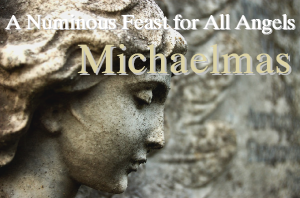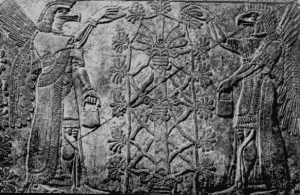
You’ve heard of Christ-mas, but have you heard of Michael-mas? It is believed the angels come down today and feast with us. All I know is, we are supposed to eat carrots for this holy day…
September 29, Michaelmas
by Soror Majad, aka Debbie Van Neste, Enochian Adept & one of our Mystery School Initiates
This is the feast day of St. Michael and all the Angels. It is the most ancient of all the angel festivals.
From fairly early on, Michaelmas was an important holiday, the religious or Christian equivalent of the autumn equinox. In England, it was considered the start of a new quarter. It marked the start of a new business year, a time for electing officials, making contracts, paying rent, hiring servants, holding court and starting school.
Obviously we still see the remnants of this in the timing of our elections and school year.
This is also a time when the weather is known to change. In Italy, they say “For St. Michael, heat goes into the heavens.” In Ireland, people expect a marked decrease in sickness or disease. The Irish also consider this a lucky day for fishing:
Plenty comes to the boat on Michael’s Day.
Barolini records a nursery rhyme about hours of sleep:
Nature requires five,
Custom gives seven,
Laziness takes nine
And Michaelmas eleven.
Michaelmas became the fixed date for the feast otherwise associated with Autumn Equinox or the harvest. As early as 1014, the laws of Ethelred in England prescribe a three day fast for all Christians before the feast. Servants weren’t allowed to work during these days. Michaelmas was a time when rents were due, and rents were often paid in food. The traditional rent for Michaelmas was a goose.
Eating something rich like goose at this turning point of the year brings good luck. In Nottingham they say “If you eat roast goose on Michaelmas day, you will never want money all year.” In Norfolk, they say, “if you don’t baste the goose on Michaelmas Day, you will want money all year.”
In Yorkshire, they use the condition of the meat of the goose to predict the weather:
If the goose breast at Michaelmas be dour and dull
We’ll have a sour winter, from the start to the full.
Fitzgibbon says the Irish used to stuff the goose with potato to cut the grease and absorb the flavor. This is like the traditional onion sauce served with goose in the 18th and 19th centuries and made from onions cooked in half milk and half water, with a slice of turnip, then mixed with butter, nutmeg, cream, salt and pepper and mashed. Apple sauce is the most common topping today.
In Italy, where this is clearly considered a harvest festival, they say “For St. Michael all the last fruits of the year are honeyed and ripe.”
Cosman says that it is traditional to eat ginger on Michaelmas. She mentions ginger ale, beer and wine, gingerbread, ginger snaps, fish baked with ginger and two ginger desserts: charwardon (made with large succulent wardon pears, cinnamon, nutmeg and ginger) and ginger caramels with curls of ginger-root shavings on top.
Michaelmas daisy is the name given to flowers of the aster family which bloom at this time. I’ve seen it applied mostly to purple asters but Barolini says she used to pick yellow Michaelmas daisies on the beaches near Rome. She also made a yellow sponge cake called “Margherita” (daisy) on that day.
St Michael
Michael is a warrior angel often pictured poised with a sword over a dragon (or demon) that he tramples underfoot. Other times he rides a white steed, and carries a three-pronged spear in his right hand and a three-cornered shield in his left. He cast Lucifer and the other evil angels out of Paradise. Thus, in the Middle Ages was invoked as the patron of knights and warriors.
He’s been honored since ancient times as a protector. Most of his churches are on high places, for instance, Mont St. Michel in Brittany, the church on the tor at Glastonbury, the church on the tumulus at Carnac. They were often built on the sites where Lugh, the Celtic God of Light, was worshipped earlier.
Although all angels are sent as messengers from on high, Michael has a special task. He’s sent to fetch the souls of those who have died for judgement. For this reason he is also considered the patron saint of all trades that use scales which mean he looks after pastry chefs and weighers of grain.
My friend Carolee Colter translated this Litany of Saint Michael from the French prayer card she purchased while visiting Mont St Michel in Brittany:
Saint Michael, archangel, pray for us.
Saint Michael, chief of all the angels, pray for us.
Saint Michael, filled with the wisdom of God, pray for us.
Saint Michael, very glorious prince, pray for us.
Saint Michael, strong in combat, pray for us.
Saint Michael, terror of demons, pray for us.
Saint Michael, vanquisher of Satan, pray for us.
Saint Michael, our support in the fight against evil, pray for us.
Saint Michael, prince of the celestial militia, pray for us.
Saint Michael, faithful servant of God, pray for us.
Saint Michael, messenger of God, pray for us.
Saint Michael, angel of peace, pray for us.
Saint Michael, guardian of Paradise, pray for us.
Saint Michael, support of the people of God, pray for us.
Saint Michael, guardian and patron of the church, pray for us.
Saint Michael, benefactor of people who honor you, pray for us.
Saint Michael, whose prayers reach to heaven, pray for us.
Saint Michael, who introduces souls to the eternal light, pray for us.
Pray for us, Saint Michael, archangel.
For more information about St Michael, see the images and information at this website: www.saintspreserved.com/michael.htm
Elegba: In the voodoo tradition, Michael is equated with Elegba, the messenger god. All ceremonies begin and end with petitions to Elegba, the god of the crossroads, whose shrine is behind the door.
Sources:
Barolini, Helen, Festa: Recipes and Recollections of Italian Holidays, Harcourt Brace Jovanovich 1988
Cosman, Madeleine Pelner, Medieval Holidays and Festivals: A Calendar of Celebrations, Scribners
Field, Carol, Celebrating Italy, William Morrow 1990
Fitzgibbon, Theodora, A Taste of Ireland: Irish Traditional Foods, NY: Avenel Books 1978, p 105
Knightly, Charles, The Perpetual Almanack of Folklore, Thames and Hudson 1987
* * * * * * * * * * * * * * * * *
For more on Michaelmas and the fascinating traditions that our foremothers and fathers kept on this day, visit these sites:
Nice slide show of foods — starting with cooked carrots! — and traditions: http://s1258.photobucket.com/user/HaleyWeasley/media/ChristianYear/michaelmas_zps4d3a79cb.jpg.html
